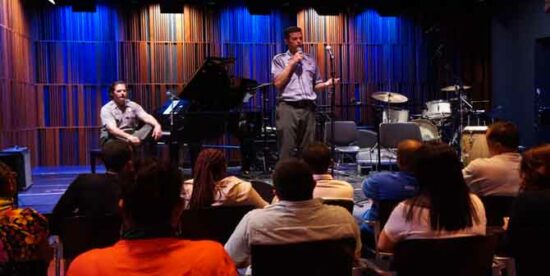
The National Park Service is celebrating its centennial this year! Global Ties U.S. wanted to showcase how our members incorporate National Parks into their international exchange programming to give visitors a truly unique experience.
The thought of a National Park conjures up images of mountainous vistas, deep canyons, acres of trees, and maybe roaming wildlife, but in New Orleans, another kind of National Park exists. Instead of a hiking trail, you’ll find a performing arts space. In lieu of wildflowers, musical instruments. There are park rangers, yes, but here they are also musicians.
In celebrating the origins of the great American art form, Jazz, the New Orleans Jazz National Historical Park is a partnership between the National Park Service and the Louisiana State Museum’s Old U.S. Mint. Jazz emerged as a result of African slaves who congregated on Sundays in New Orleans’ Congo Square to express their musical traditions.
In May, the New Orleans Citizen Diplomacy Council hosted an International Visitor Leadership Program group comprised of tourism professionals from countries as varied as Ethiopia, India, Jamaica, Papua New Guinea, Suriname, Tajikistan, and Ukraine. The group visited the Jazz National Historical Park Old U.S. Mint location for a glimpse into the value that Jazz music and the Park add to the tourism experience in New Orleans. Park rangers Jon Beebe and Bud Holmes treated the visitors to a Jazz rendition of “You are My Sunshine,” as well as a descriptive history of local jazz traditions and favorite Jazz pioneers and contemporary artists like Professor Longhair, Harry Connick, Jr., and Kermit Ruffins.
Also discussed were partnerships, public relations, and programs—like Music for All Ages. The program targets youth and provides an opportunity for them to jam—at any skill level—with local brass bands. Visitors also viewed Louis Armstrong’s cornet, a brass instrument similar to the trumpet, and supported the Park through some gift shop purchases.
The Jazz National Historical Park engages in exchanges of its own too. Recently, it organized a program for French-speaking musicians from around the world, including from Louisiana, to come together and perform. South African visitor Thandekile “Jessica” NHLEKO expressed particular interest in music exchanges, noting that a South African colleague would be performing in Essence Fest in New Orleans in July. Along with the New Orleans Jazz National Historical Park, New Orleans is home to several other National Parks, including the Barataria Preserve and the Chalmette Battlefield.
by Emily Ramirez Hernadez, New Orleans Citizen Diplomacy Council
